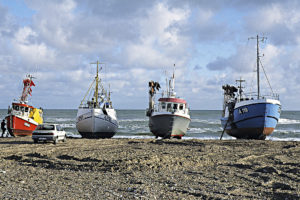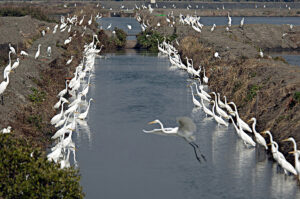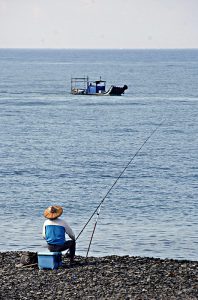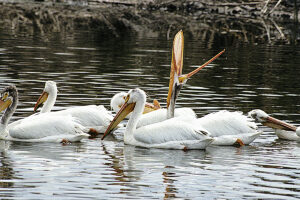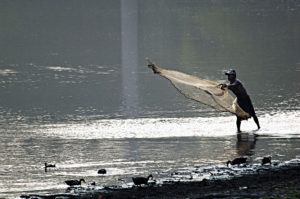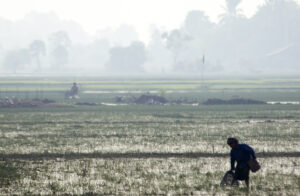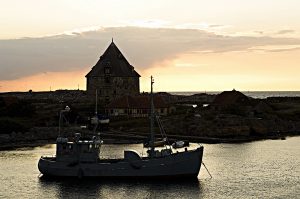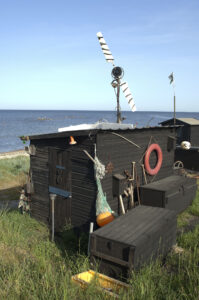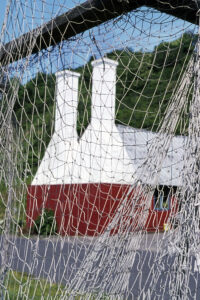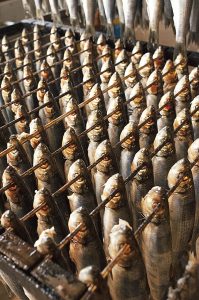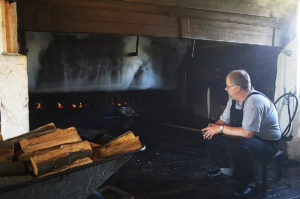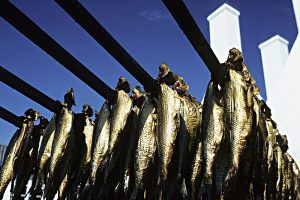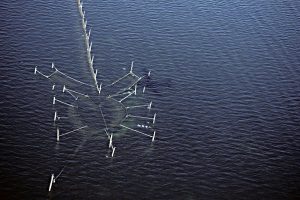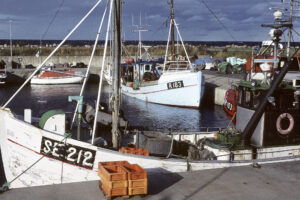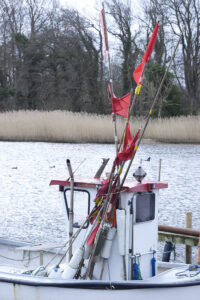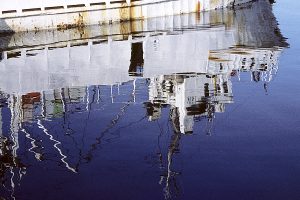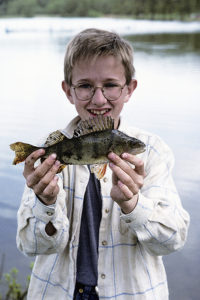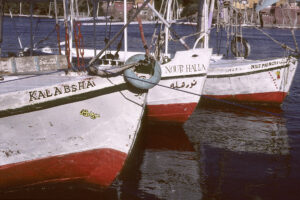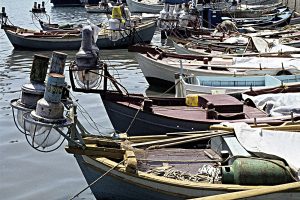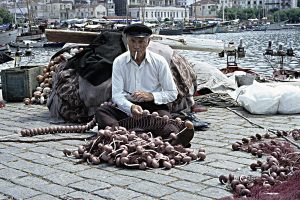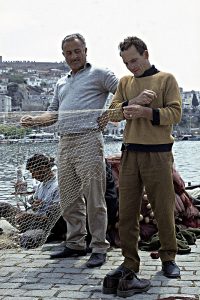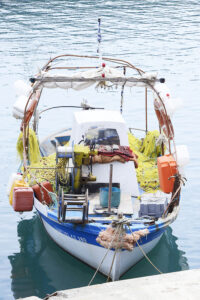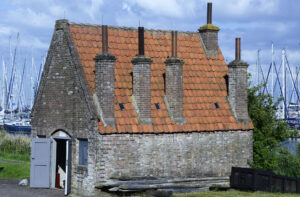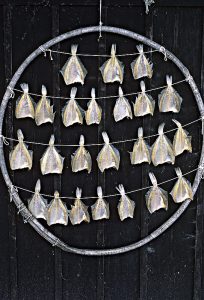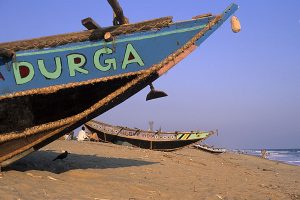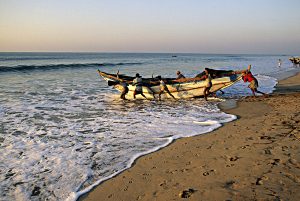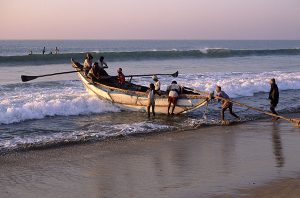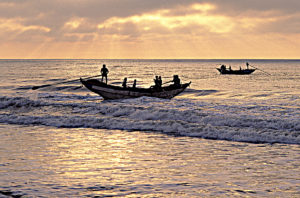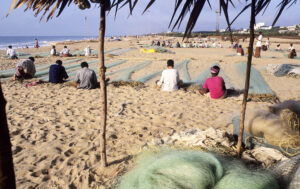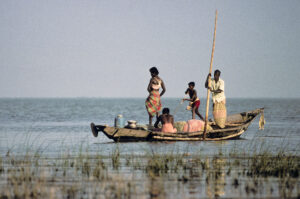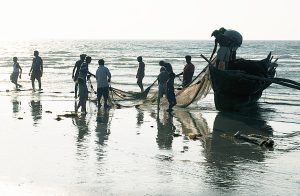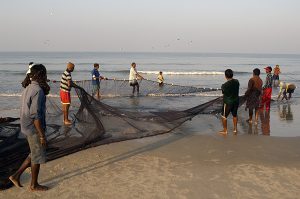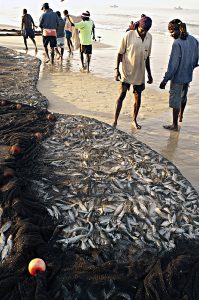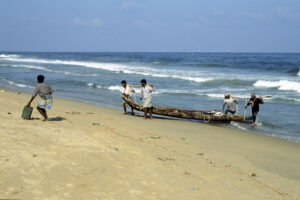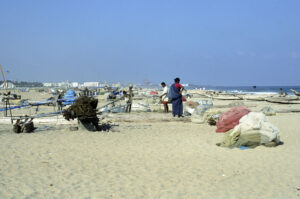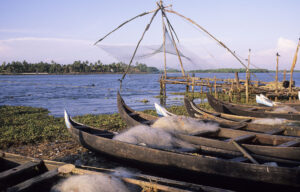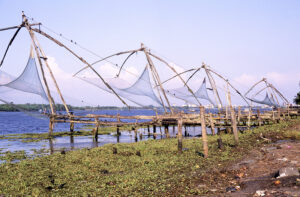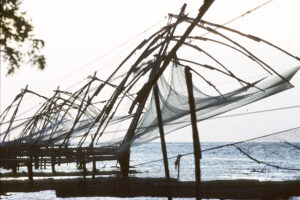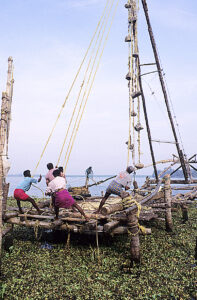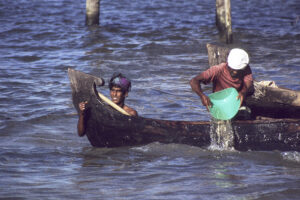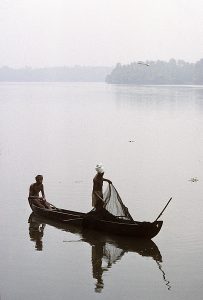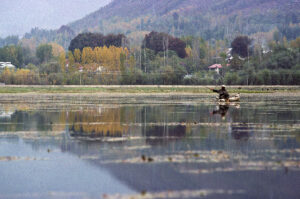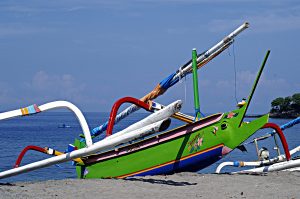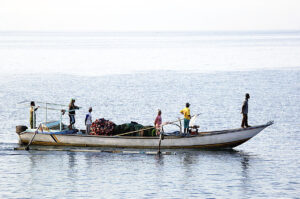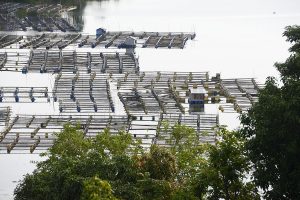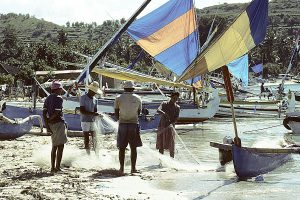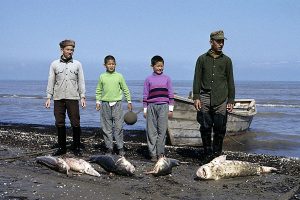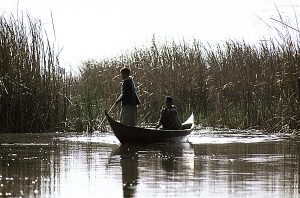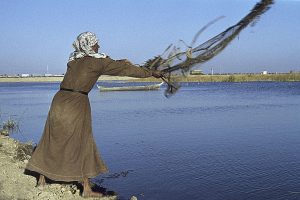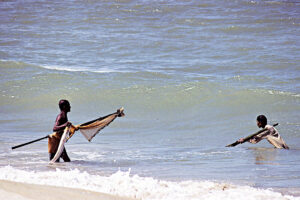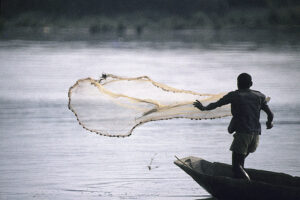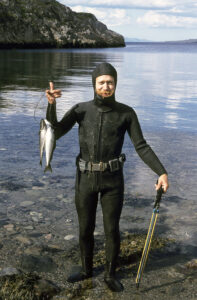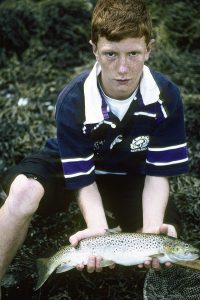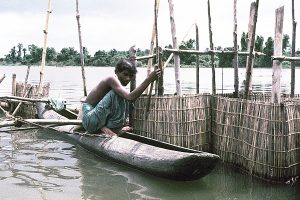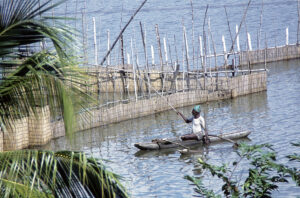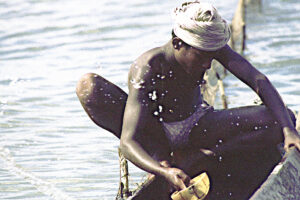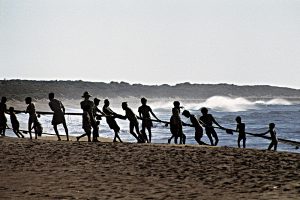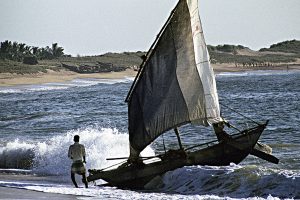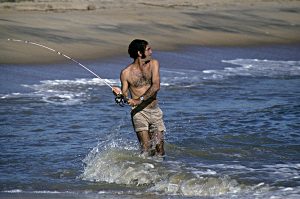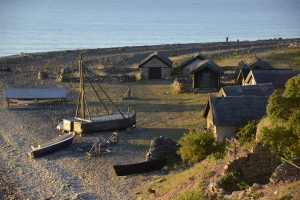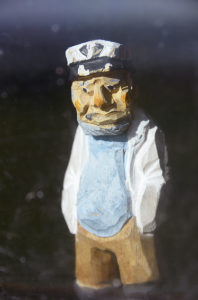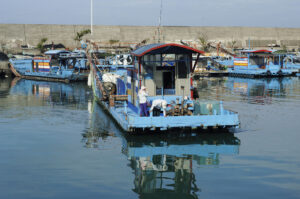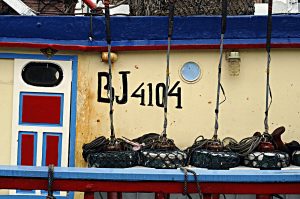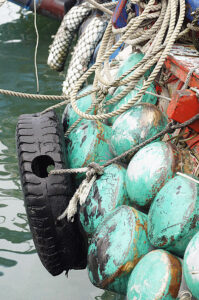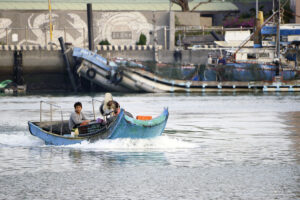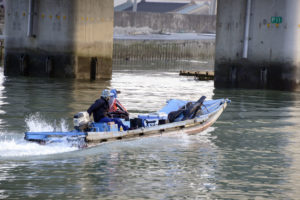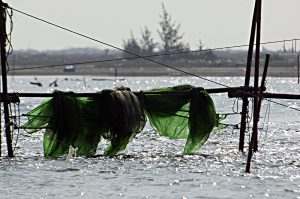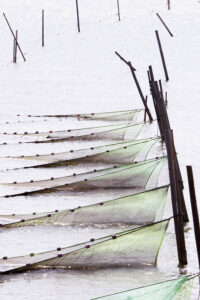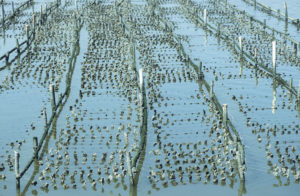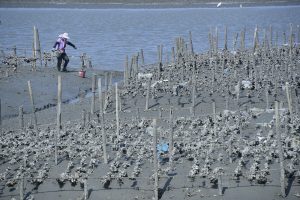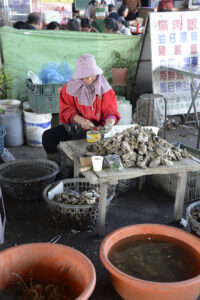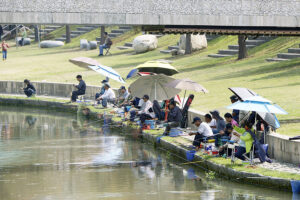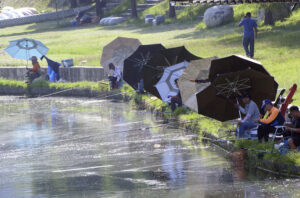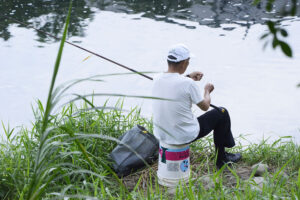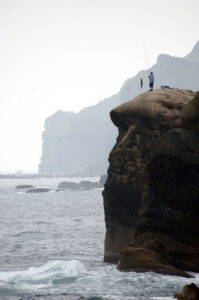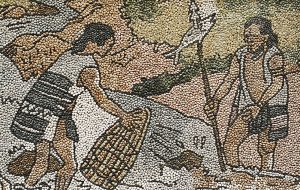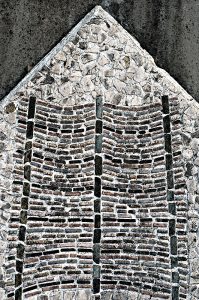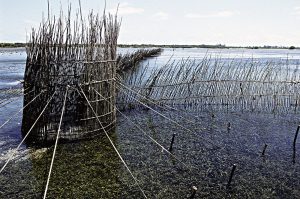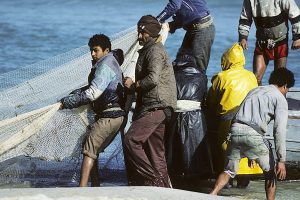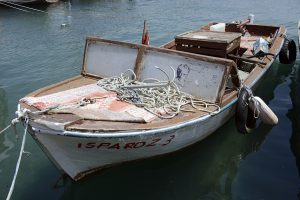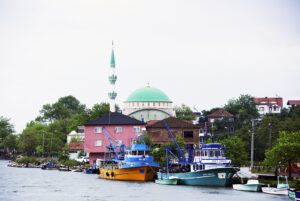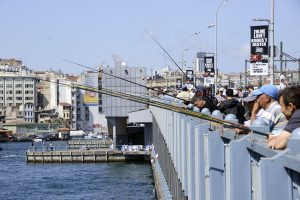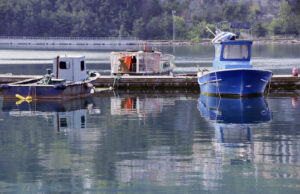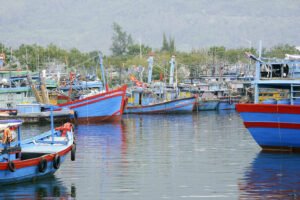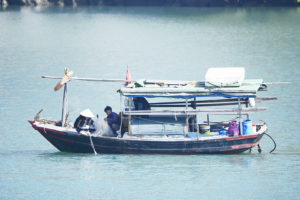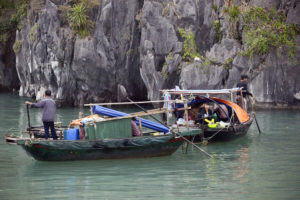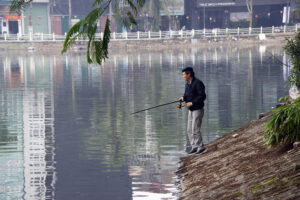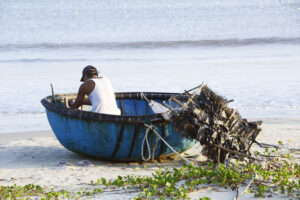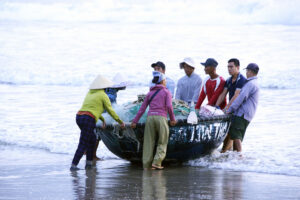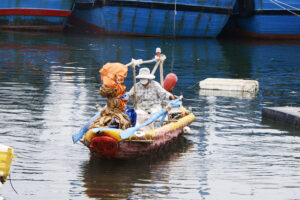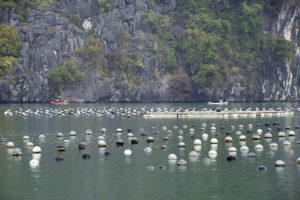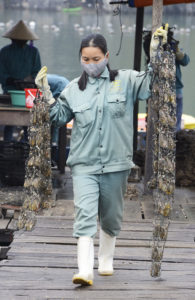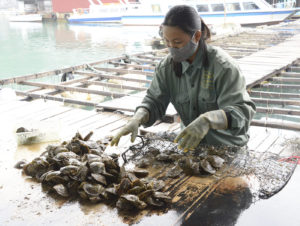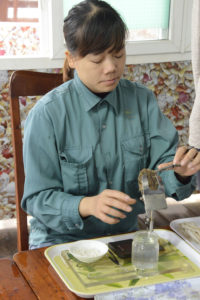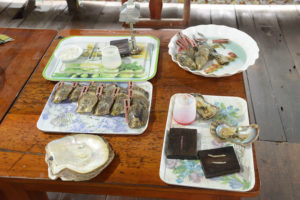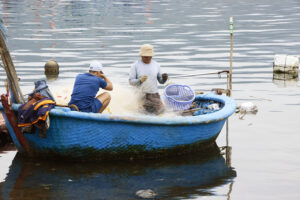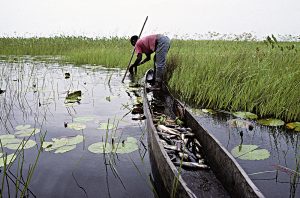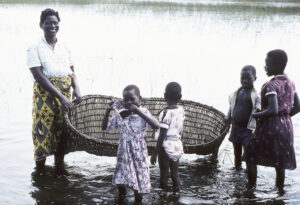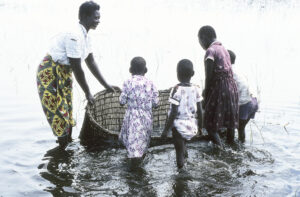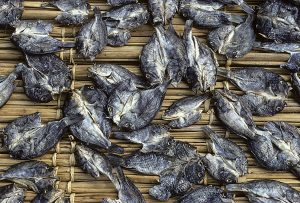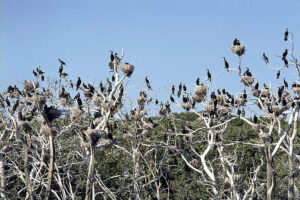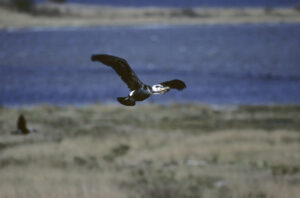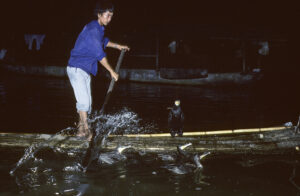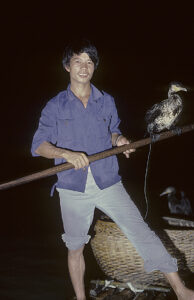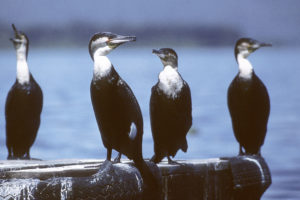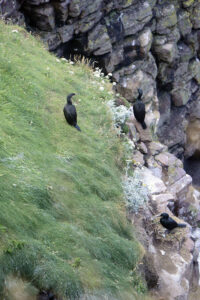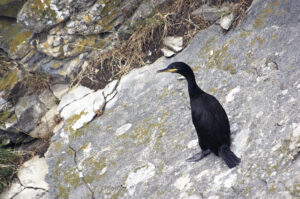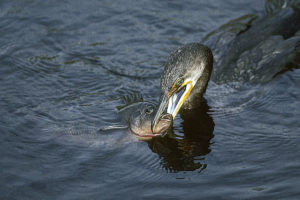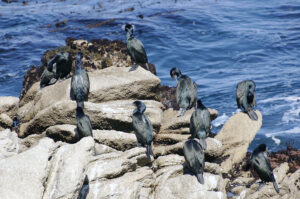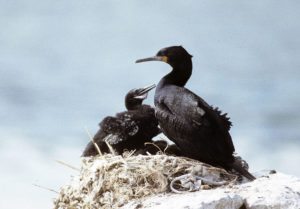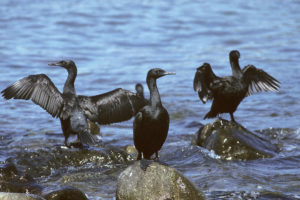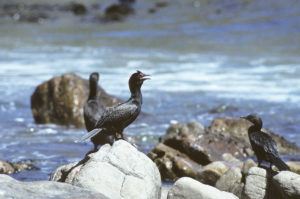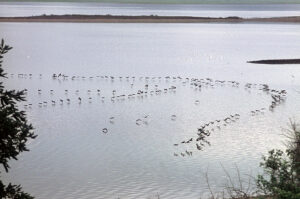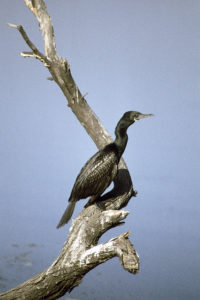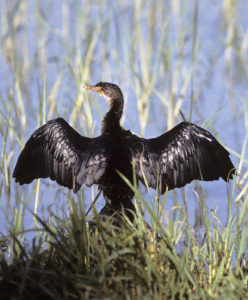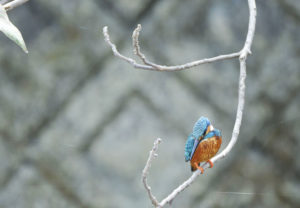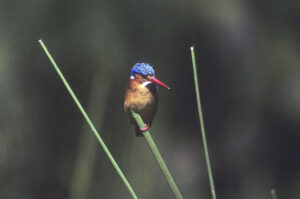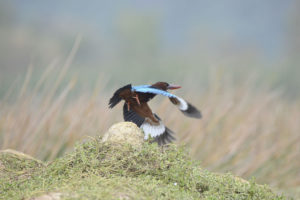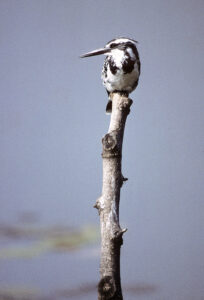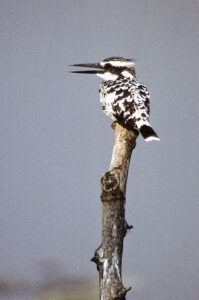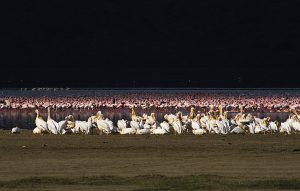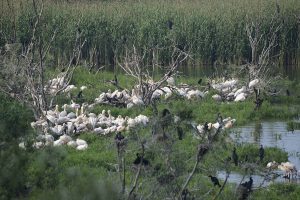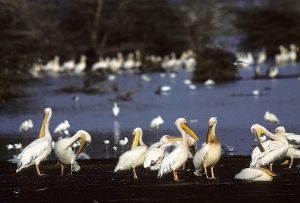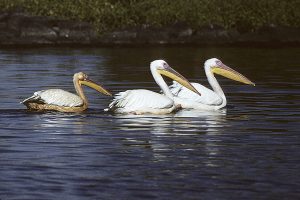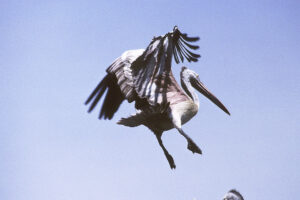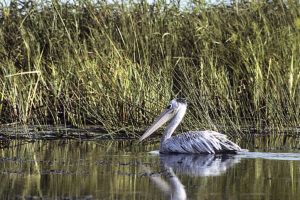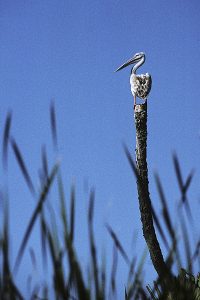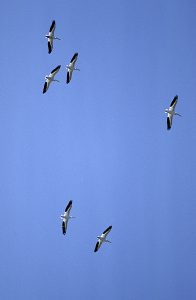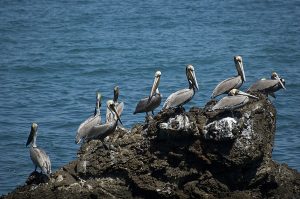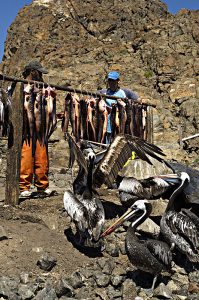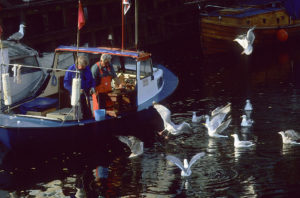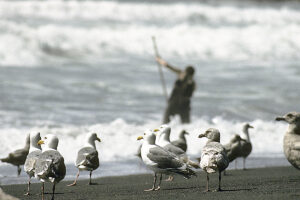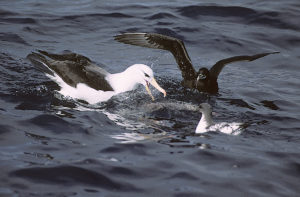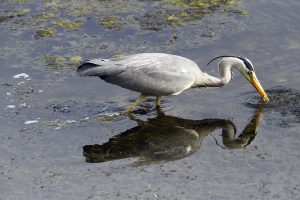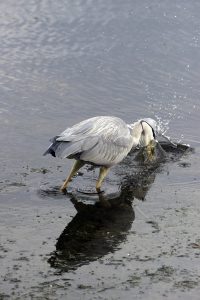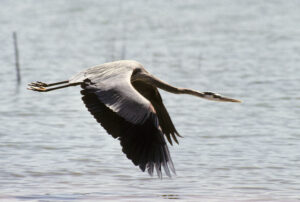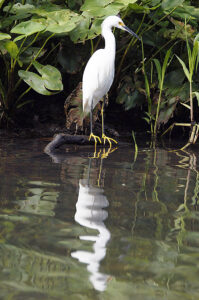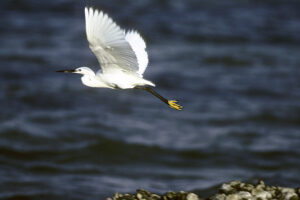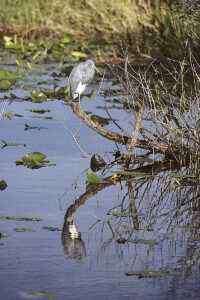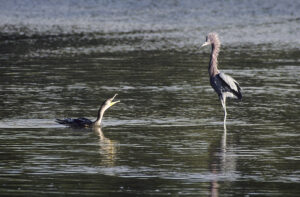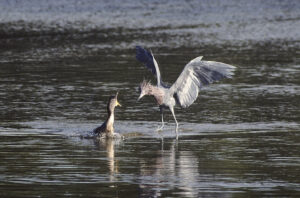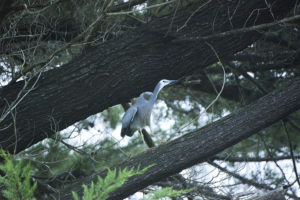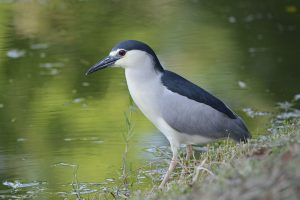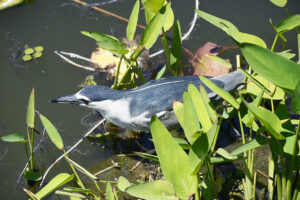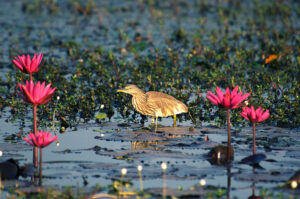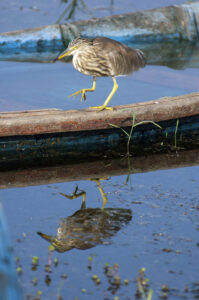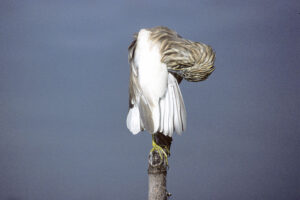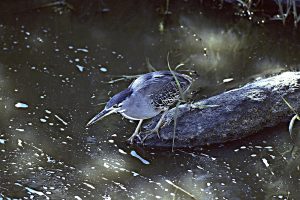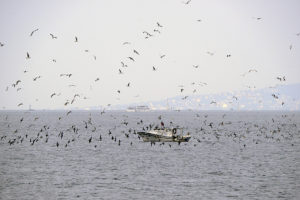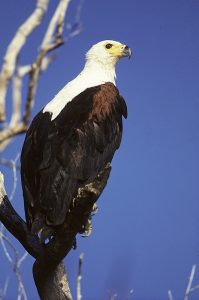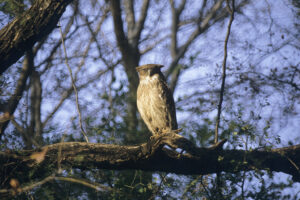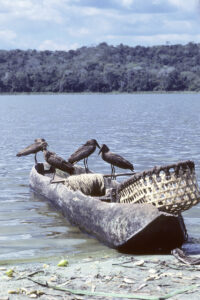Fishing
Nowadays, most fishing vessels in Denmark are anchored in harbours. A few places, though, like here at Torup Strand, Jutland, fishermen still haul their boats ashore, using huge winches. (Photo copyright © by Kaj Halberg)
Numerous great white egrets (Ardea alba) and little egrets (Egretta garzetta) on the lookout for fish along a canal, Cigu Wetlands, near the city of Tainan, southern Taiwan. (Photo copyright © by Kaj Halberg)
A fishing vessel is on its way to the harbour in Fangliao, Taiwan, while an angler tries his luck at the shore. (Photo copyright © by Kaj Halberg)
American white pelicans (Pelecanus erythrorhynchos), Klamath National Wildlife Refuge, California. One bird shows its enormous gular pouch, which swells tremendously, when the bird is fishing – like some kind of basket. To the left an immature bird with greyish head. (Photo copyright © by Kaj Halberg)
Undoubtedly, fishing has been one of the most important occupations since the arrival of Mankind. Below is a number of pictures, arranged alphabetically according to country name. A selection of fish-eating birds are presented at the bottom of the page.
Cambodia
Surrounded by feeding domestic ducks, the fisherman in the picture below throws his cast net into a pond near Angkor Thom. This simple type of fishing net consists of a circular net with metal rings, or other heavy material, tied around the edge, and a rope to the centre. When the net hits the surface, the metal rings pull the outer part of the net towards the bottom, thus trapping the fish, which happen to be under it. Naturally, this method of fishing requires a lot of work, often with a meagre result.
(Photo copyright © by Kaj Halberg)
Catching fish in an inundated rice field, using baskets, Pre Rup. (Photo copyright © by Kaj Halberg)
Denmark
In the 1600s, a number of wars were fought between Denmark and Sweden. The Danish King, Christian V, ordered a fortress erected on a tiny islet near the island of Bornholm, in the Baltic Sea, south of Sweden. Construction took place 1684-1687. This island, which until then had been uninhabited, was named Christiansø, in honour of the king. Later, the neighbouring island was named Frederiksø, in honour of his successor, Frederik IV.
At dusk, a fishing boat returns to the harbour on Christiansø. In the late 1600s, the tower in the background served as a watch tower, and later it became a prison for enemies of the king. (Photo copyright © by Kaj Halberg)
Fisherman’s hut, Sorthat, Bornholm. (Photo copyright © by Kaj Halberg)
A common method of preserving fish is to smoke them for a prolonged period of time, which also makes the water in them evaporate. The following pictures are from Bornholm, which in former times held hundreds of smoke houses. Still today, a number of these have been preserved for the tourist industry, as smoked Atlantic herring (Clupea harengus) is a local delicacy.
Fishing nets, hung up to dry near a smoke house at Helligpeder. (Photo copyright © by Kaj Halberg)
Jet plane, passing over a smoke house in the town of Hasle. (Photo copyright © by Kaj Halberg)
Herrings, ready to be smoked, Hasle. (Photo copyright © by Kaj Halberg)
Smoking the herrings, Hasle. (Photo copyright © by Kaj Halberg)
Smoked herrings, placed outside the smoke house at Hasle to dry a bit in the sun, before being sold. (Photo copyright © by Kaj Halberg)
Aerial photograph of a huge fish trap, Storebælt. (Photo copyright © by Kaj Halberg)
Fishing vessels, Listed Harbour, Bornholm. (Photo copyright © by Kaj Halberg)
Atlantic cods (Gadus morhua) in a basket, Bornholm. (Photo copyright © by Kaj Halberg)
Cleaning a fishing vessel, Bornholm. (Photo copyright © by Kaj Halberg)
Fishing boat with buoys, Nyborg, Funen. (Photo copyright © by Kaj Halberg)
Fishing vessel, reflected in water, Nexø Harbour, Bornholm. (Photo copyright © by Kaj Halberg)
This boy proudly presents his catch, a perch (Perca fluviatilis), Lake Rørbæk, central Jutland. (Photo copyright © by Kaj Halberg)
Egypt
Fishing boats, Aswan. (Photo copyright © by Kaj Halberg)
Greece
Many places around the world, fishing is done at night, luring the fish close with the help of illuminated lamps. This picture is from Kavala. (Photo copyright © by Kaj Halberg)
Fishermen, mending their nets, Kavala. (Photos copyright © by Kaj Halberg)
Tiny, but well-equipped fishing boat, Sougia, Crete. (Photo copyright © by Kaj Halberg)
Holland
A common method of preserving fish is to smoke them for a prolonged period of time, which also makes the water in them evaporate. This smokery in Enkhuizen is today a museum. (Photo copyright © by Kaj Halberg)
Air-drying is an ancient method of preserving fish, in which the water in the fish evaporates, inhibiting the growth of bacteria and fungi. In this picture, flat fish are drying on a wall in West-Friesland. (Photo copyright © by Kaj Halberg)
Iceland
Boy, angling for trout, Lake Isholsvatn. (Photo copyright © by Kaj Halberg)
India
Near the town of Puri, Odisha (Orissa), you can still watch fishermen, working the traditional way. Their flat-bottomed boats consist of planks, which are ’sewn’ together, using thick grass ropes.
At dawn, the fishermen push these boats through the surf, placing a huge fishing net from the shore, so that it forms an inverted ‘U’. Now follows several hours of hard work, when the fishermen, often assisted by their wives, haul the net ashore. Usually, their catch is rather small, and in later years it has been further diminished due to overfishing by trawlers from Kolkata (Calcutta).
The catch is placed in baskets or in carapaces of sea turtles, which the women carry on their head to their homes, situated just above the beach.
Traditional Puri fishing boats. The planks are ‘sewn’ together, using thick grass ropes. Durga – also known by the names Parvati, Devi, Uma, or Kali – is the most important goddess in the Hindu pantheon. (Photos copyright © by Kaj Halberg)
At dawn, Puri fishermen push their boats out to sea. (Photos copyright © by Kaj Halberg)
Puri fishermen, hauling a huge net ashore, assisted by their wives. (Photos copyright © by Kaj Halberg)
After emptying the nests, the fishermen mend them, sitting on the beach. (Photo copyright © by Kaj Halberg)
Fishermen, punting their boat, Lake Chilka, Odisha (Orissa). (Photo copyright © by Kaj Halberg)
Fishermen at work on Colva Beach, Goa, hauling a boat ashore (top), rinsing a huge net in the sea (second from above), hauling a huge net ashore (second from below), and admiring the catch (bottom). (Photos copyright © by Kaj Halberg)
Fishermen, pulling their primitive boat ashore, Marina Beach, Chennai, Tamil Nadu. (Photos copyright © by Kaj Halberg)
Chinese fishing nets were introduced to Kerala, South India, in the 1300s by Chinese fugitives. Each net is tied to a creaking wooden framework, which, by using an ingenious system of levers, large stones, and ropes, and the work of 3 to 5 men, can be raised or lowered into the water.
Fishing boats and Chinese fishing net, Kochi, Kerala. (Photos copyright © by Kaj Halberg)
Fishermen on their way out through the narrow passage, leading into Kochi. The current is strong. The lower picture shows the helmsman on the same boat. (Photos copyright © by Kaj Halberg)
These fishermen in Kochi use a bucket, cut in half, to empty their boat of water. (Photo copyright © by Kaj Halberg)
Fishermen, hauling a net into their boat, Lake Ashtamudi, Kerala. This lake constitutes a part of a huge wetland, known as Kuttanad, or backwaters. (Photo copyright © by Kaj Halberg)
Man angling from a boat, Dal Lake, Kashmir. (Photo copyright © by Kaj Halberg)
Indonesia
Colourful fishing boat, shaped like a swordfish, Senggigi, Lombok. (Photo copyright © by Kaj Halberg)
Fishing boat, returning to Senggigi. (Photo copyright © by Kaj Halberg)
Fish cages, Lake Batur, Bali. (Photo copyright © by Kaj Halberg)
Fishermen, cleaning a net, Padang Bai, Bali. (Photo copyright © by Kaj Halberg)
Iran
The Caspian Sea, the world’s largest saltwater lake, is home to a large number of fish species, including the sturgeon (Huso huso). The picture below shows fishermen with their catch of sturgeons, on the Mian Kaleh sand spit in the south-eastern part of the lake. This interesting area is described in depth on the page Travel episodes – Iran 1973: Car breakdown at the Caspian Sea.
(Photo copyright © by Kaj Halberg)
Iraq
For thousands of years, a huge marsh area in southern Iraq, between the Euphrates and Tigris Rivers, was the home of the Madan tribe, whose way of life was completely adapted to the wet habitat. They moved about in canoes, built their reed houses on islets, and made a living by hunting and fishing, growing rice, and raising water buffaloes.
The regime of Saddam Hussein Abd al-Majid al-Tikriti (1979-2003) put an end to their way of life by draining the marshes, as a retaliation for the Madan siding with the Americans during the First Gulf War (1990-1991).
This interesting wetland is presented in detail on the pages Travel episodes – Iraq 1973: The hospitable mudir, and Iraq 1973: Dust storm and sheep’s head.
Madan tribal boys, fishing with a leister in the marshes of southern Iraq. (Photo copyright © by Kaj Halberg)
The fisherman in the picture below throws his cast net into a lake near the great marshes. This simple type of fishing net consists of a circular net with metal rings, or other heavy material, tied around the edge, and a rope to the centre. When the net hits the surface, the metal rings pull the outer part of the net towards the bottom, thus trapping the fish, which happen to be under it. Naturally, this method of fishing requires a lot of work, often with a meagre result.
(Photo copyright © by Kaj Halberg)
Malaysia
These men at Marang are fishing in the surf, using a net, which is attached to two poles, tied together at one end, and pushed forward on the sea bottom. (Photo copyright © by Kaj Halberg)
Nepal
A huge marsh area is found along the great Kosi River in southern Nepal. After a night’s catch in these marshes, fishermen are hanging up their nets to dry in the sun. (Photo copyright © by Kaj Halberg)
The fisherman in the picture below throws his cast net into the Rapti River. This simple type of fishing net consists of a circular net with metal rings, or other heavy material, tied around the edge, and a rope to the centre. When the net hits the surface, the metal rings pull the outer part of the net towards the bottom, thus trapping the fish, which happen to be under it. Naturally, this method of fishing requires a lot of work, often with a meagre result.
(Photo copyright © by Kaj Halberg)
Norway
Air-drying is an ancient method of preserving fish, in which the water in the fish evaporates, inhibiting the growth of bacteria and fungi. In this picture, fish are drying on a scaffold in the village of Ekkerøy, Varanger Peninsula. (Photo copyright © by Kaj Halberg)
This young man is proudly presenting his catch, acquired with a fishing harpoon, northern Norway. (Photo copyright © by Kaj Halberg)
Philippines
The Ifugao is one out of a dozen Malayan tribes, who inhabit northern Luzon. At least 2,000 years ago, this people constructed fantastic terraced fields on the mountain slopes, irrigated through an advanced system of canals. On these terraces, they grow their main staple, rice, supplied with sweet potatoes, taro, and various vegetables. They also raise chickens and black pigs, and the men hunt wild animals in the jungle.
My adventures among Ifugao people are related on the page Travel episodes – Philippines 1984: Shamanism among Ifugao tribals.
Using a small net, this Ifugao boy is catching fish in an inundated rice field near Banawe, Luzon. (Photo copyright © by Kaj Halberg)
Scotland
Tim Fison and his two sons, Damien and Alastair, angling for sea trout (Salmo trutta) in Loch Hourn. (Photos copyright © by Kaj Halberg)
In Lake Bolgoda, south-western Sri Lanka, Sinhalese fishermen produce fish traps, consisting of mats made from split, 1.5-metre-long, thin bamboo stems, which are tied together with string at the upper and lower ends, and in the middle. These mats are tied to poles, which are stuck into the lake bottom, forming two rows. The distance between these rows gradually decreases, with a large sack tied to the opening at the end. During the day, fish are attracted by fodder, at night by lighted kerosene lamps, which are tied to the poles.
My adventures among fishermen in Lake Bolgoda are related on the page Travel episodes – Sri Lanka 1976: Among alcohol brewers.
Fisherman at his fish trap, Lake Bolgoda. The boat is an outrigger, with a smaller trunk on one side, attached to the canoe by two branches. (Photo copyright © by Kaj Halberg)
This man is trying his luck with a fishing rod, Lake Bolgoda. (Photo copyright © by Kaj Halberg)
This fisherman has caught a spiny lobster in his fish trap, Lake Bolgoda. (Photo copyright © by Kaj Halberg)
This fisherman in Jaffna is emtying his canoe of water, using a buoy, cut in half. (Photo copyright © by Kaj Halberg)
Angler on a beach south of Colombo. (Photo copyright © by Kaj Halberg)
Fishermen, hauling ashore a huge net, Hambantota. (Photo copyright © by Kaj Halberg)
Fisherman, hauling his boat through the surf, Hambantota. (Photo copyright © by Kaj Halberg)
This Burgher (a person of mixed Sinhalese and European descent) is angling in the sea at Yala National Park. (Photo copyright © by Kaj Halberg)
Sweden
Bruddesta, Öland, in evening light. This abandoned fishing village has been preserved as a museum, including huts, boats, and winches, the purpose of which was to haul the boats on land. (Photo copyright © by Kaj Halberg)
Overhauling a fishing boat, Böda Harbour, Öland. (Photo copyright © by Kaj Halberg)
This carved wooden figure, depicting a fisherman, has been placed on the window sill of a fisherman’s hut, Kapelludden, Öland. (Photo copyright © by Kaj Halberg)
Taiwan
Numerous fishing vessels in Nanfangao, a large fishing harbour south of Yilan. (Photo copyright © by Kaj Halberg)
Colourful fishing boats, Wushe Fishing Harbour, north-eastern Taiwan (top), and Fangliao, western Taiwan. (Photos copyright © by Kaj Halberg)
Many places around the world, fishing is done at night, luring the fish close with the help of illuminated lamps. This picture is from Bitou, north-eastern Taiwan. (Photo copyright © by Kaj Halberg)
Fishing vessel, Wushe Fishing Harbour, north-eastern Taiwan. (Photo copyright © by Kaj Halberg)
Fisherman, cleaning a net on board his vessel, Wushe. (Photo copyright © by Kaj Halberg)
Fishing vessel near Shengang, western Taiwan. Loosely translated, the text on the boat means: ‘Bring in lots of fish, and you will make lots of money’. (Photo copyright © by Kaj Halberg)
These fishing vessels in Fangliao are constructed of thick metal pipes, bent up at bow and stern. (Photo copyright © by Kaj Halberg)
Close-up of the same type of metal pipes, Wushe. The fender is an old car tyre. (Photo copyright © by Kaj Halberg)
On these fishing boats in the town of Budai, the bottom consists of metal, bent up and flattened at the stern, which makes it easier to haul in a net. (Photos copyright © by Kaj Halberg)
Fishing nets and poles, near Tainan (top), and at the Aogu Wetlands. (Photos copyright © by Kaj Halberg)
Oyster farming, Cigu Wetlands, near Tainan (top), and Xianxi, north of Lugang. (Photos copyright © by Kaj Halberg)
Woman, taking oysters out of the shell, near Shengang, western Taiwan. (Photo copyright © by Kaj Halberg)
Taiwanese people love doing things in groups. In these picture, anglers are enjoying a pleasant morning along the Han River in the city of Taichung. (Photos copyright © by Kaj Halberg)
As a contrast, this Taiwanese angler at the Fazi River, Taichung, prefers to work alone. (Photo copyright © by Kaj Halberg)
This angler, standing on a rock at Nanya Peculiar Rocks, northern Taiwan, has just caught a fish. (Photo copyright © by Kaj Halberg)
The indigenous population of Taiwan is composed of numerous peoples of Malayan origin, who still live in the mountains. Formerly, these tribes had a rich and colourful culture, which has been partially preserved, for example in their artwork.
Other pictures, depicting this artwork, are shown on the page Culture: Tribal art of Taiwan.
Mosaic, depicting fishermen with a trap and a spear, artwork of members of the Atayal tribe Tian Gou (‘Heavenly Dog’), who live near Dongshih. (Photo copyright © by Kaj Halberg)
This mosaic, artwork of the Atayal tribe Tian Gou near Dongshih, depicts a fishing net. (Photo copyright © by Kaj Halberg)
This image, made from broken tiles, depicts an old woman, angling in a stream, artwork of the Maopu people, who live near Hsinchu. (Photo copyright © by Kaj Halberg)
Tanzania
Fish trap, made from woven straw, Cape Kilwa. (Photo copyright © by Kaj Halberg)
Tunisia
Fishermen, hauling in a large net, Sousse. (Photo copyright © by Kaj Halberg)
Turkey
This tiny fishing vessel was photographed in the town of Mordogan, Karaburun Peninsula, near Izmir. Note the faded image of Mustafa Kemal Atatürk, birth name Ali Rıza oğlu Mustafa (1881-1938), who was the founder of the Republic of Turkey and its first president 1923-1938. (Photo copyright © by Kaj Halberg)
Fishing vessels and a mosque, Melenağzi, between Akçakoca and Karasu, Black Sea. (Photo copyright © by Kaj Halberg)
In spring, huge shoals of sardines (Sardina pilchardus) and other fishes migrate through the Marmara Sea. Every day, a large number of anglers gather on the Galata Bridge, which spans the Golden Horn, Istanbul. (Photo copyright © by Kaj Halberg)
Fishing vessels, Amasra, Black Sea. (Photo copyright © by Kaj Halberg)
United States
Anglers near San Francisco, California. (Photo copyright © by Kaj Halberg)
Vietnam
Fishing vessels, Da Nang. (Photos copyright © by Kaj Halberg)
Fishing boats, Halong Bay. (Photos copyright © by Kaj Halberg)
Angler, trying his luck in the highly polluted Lake Truc Bac, Hanoi. I observed several dead fish, floating on the surface. (Photo copyright © by Kaj Halberg)
Basket boats, or coracles, locally called thung chai, Da Nang. This boat type is described on the page Culture: Boats and ships. (Photos copyright © by Kaj Halberg)
Tiny fishing boat, Da Nang. (Photo copyright © by Kaj Halberg)
Pearls are formed inside the shell of various types of mussels as a defense mechanism against an irritant, for example a grain of sand or a parasite, which has entered the shell. To lessen the irritation, the mussel creates a pearl sac, in which it deposits calcium carbonate around the foreign body.
Pearls are formed in both freshwater mussels, family Unionidae, and in oysters of the family Pteriidae, which live in saltwater. Both types of pearls are widely cultivated. The pictures below show cultivation of saltwater oysters in Halong Bay.
The oysters are kept in huge cages, in which each oyster is attached to a string inside a net. (Photos copyright © by Kaj Halberg)
Cleaning the oyster shells. (Photos copyright © by Kaj Halberg)
Opening oysters to extract pearls, or to insert an irritant. (Photos copyright © by Kaj Halberg)
Fishermen, cleaning their net, Da Nang. (Photo copyright © by Kaj Halberg)
Zambia
The Unga are a Bantu people, who live on islands in the great Bangweulu Swamps, northern Zambia. Their main occupation is fishing, and they also grow manioc, or kassava (Manihot esculenta), besides collecting a number of wild plants, such as rhizomes of water-lilies (Nymphaea) and roots of papyrus (Cyperus papyrus). They also hunt birds and antelope.
This interesting wetland is described on the page Countries and places: Bangweulu – where water meets the sky.
Every year, most Ungas spend several months in temporary fishing villages, far into the Bangweulu Swamps. The hut looks primitive, but is wonderfully cool, as the grass walls allow the wind to blow through the hut. (Photo copyright © by Kaj Halberg)
These boys assist a man, removing the catch from a net. (Photo copyright © by Kaj Halberg)
Unga fisherman, hauling up his net. (Photo copyright © by Kaj Halberg)
Unga woman and children, catching fish in large baskets. The children drive shoals of small fish towards the woman, who scoops them up into the basket. (Photos copyright © by Kaj Halberg)
This picture shows fish, drying on mats which are placed on a scaffold made from branches, in a temporary fishing camp. (Photo copyright © by Kaj Halberg)
Unga man, mending his fishing net. (Photo copyright © by Kaj Halberg)
The catch of the day, Lochinwar National Park. (Photo copyright © by Kaj Halberg)
Fish-eating birds
Cormorants
Cormorants and shags are a cosmopolitan family of about 41 species of small to medium-sized, fish-eating birds. Recent genetic studies have concluded that these birds should be placed in 7 genera: Phalacrocorax (12 species), Leucocarbo (16 species), Microcarbo (5 species), Urile (3 species), Nannopterum (3 species), Gulosus (European shag), and Poikilocarbo (red-legged cormorant).
This relief from the Khmer Empire (c. 800-1430 A.D.), displayed at Bayon, Angkor Thom, Cambodia, depicts various items, including a cormorant, swimming among fish. (Photo copyright © by Kaj Halberg)
The generic name Phalacrocorax is from the Greek phalakros (‘bald’) and korax (‘raven’), thus ‘the bald raven’, where bald refers to the white crown of the great cormorant (Phalacrocorax carbo) during the breeding season, whereas raven refers to its predominantly black plumage. This bird has an extremely wide, but rather patchy, distribution, found all over Europe and most of Asia, in Australia and New Zealand, and in north-eastern North America and Greenland. In the 1800s, it was persecuted all over Europe, partly because it was competing with fishermen, partly because its guano destroyed the trees, in which it was breeding.
Colony of great cormorant, Nature Reserve Vorsø, Horsens Fjord, Denmark, 1978, at that time one of only three cormorant colonies in Denmark. Since then, it has expanded enormously. (Photo copyright © by Kaj Halberg)
A great cormorant in breeding plumage brings nesting material to its nest in the colony on Vorsø. (Photo copyright © by Kaj Halberg)
For thousands of years, fishermen at various locations in China have been using tamed great cormorants, of the subspecies sinensis, for fishing. The pictures below are from the Li River, Guangxi Province.
(Photos copyright © by Kaj Halberg)
The white-breasted cormorant (Phalacrocorax lucidus), which is found in eastern and southern Africa, resembles the great cormorant, but may be identified by its white head, neck, and upper breast. Some authorities do not recognize this bird as a full species, but as a subspecies, lucidus, of the great cormorant.
White-breasted cormorants, resting on a pontoon, Lake Naivasha, Kenya. (Photo copyright © by Kaj Halberg)
The common shag (Gulosus aristotelis) breeds on rocky coasts, from Iceland, northern Norway, and the Kola Peninsula southwards to the Mediterranean and the Black Sea. The northernmost populations are migratory. It is the only member of the genus, named from the Latin word for gluttonous. The specific name commemorates the Greek philosopher Aristotle (384-322 B.C.).
Shags on their breeding site at Cap Frehel, Brittany. (Photos copyright © by Kaj Halberg)
Shag of the eastern subspecies desmarestii, observed in a breeding colony near the city of Şile, Black Sea. (Photo copyright © by Kaj Halberg)
Divided into five subspecies, the double-crested cormorant (Nannopterum auritum) is very common in the major part of North America, from the Aleutian Islands in the Bering Sea across the continent to eastern Canada, southwards through the entire United States to northern Mexico and the Bahamas.
The specific name means ‘eared’ in Latin, which, like the common name double-crested, refers to its twin crests during the breeding season, one on each side of the head.
This double-crested cormorant in Everglades National Park, Florida, has just caught a fish, grabbing it with its strong beak, which is equipped with a hook. (Photo copyright © by Kaj Halberg)
Brandt’s cormorant (Urile penicillatus) is a marine species, distributed along the entire North American Pacific Coast, from Alaska southwards to Baja California and the coast of Sinaloa, Mexico.
Preening Brandt’s cormorants, Point Lobos State Reserve, California. (Photo copyright © by Kaj Halberg)
The Cape cormorant (Phalacrocorax capensis) is a southern African species, breeding on coasts of Angola, Namibia, and western and southern South Africa. Outside the breeding season, it has been recorded as far north as Congo Brazzaville on the west coast, and southern Mozambique on the east coast.
Cape cormorant with chicks, Lambert’s Bay, South Africa. (Photo copyright © by Kaj Halberg)
When this fishing vessel, anchored in Lambert’s Bay, had been out of use for some time, it was inhabited by Cape cormorants, which built nests several places on the vessel. (Photo copyright © by Kaj Halberg)
Another southern African species is the bank cormorant (Phalacrocorax neglectus), which breeds on coasts from central Namibia southwards to Cape Agulhas. Outside the breeding season, it disperses northwards to north-western Namibia.
Bank cormorants, drying their wings, Kommetjie, Cape Town, South Africa. (Photo copyright © by Kaj Halberg)
Yet another species in south-western Africa is the small crowned cormorant (Microcarbo coronatus), which may be identified by its long crest on the forecrown. It is distributed along the coast from central Namibia southwards to Cape Agulhas.
Crowned cormorant, Kommetjie, Cape Town, South Africa. (Photo copyright © by Kaj Halberg)
The Indian cormorant (Phalacrocorax fuscicollis), also called Indian shag, is predominantly restricted to inland waters, having a patchy distribution from Pakistan, India, and Sri Lanka eastwards to Southeast Asia.
Indian cormorants, flying in formation, Minneriya Tank, Sri Lanka. The white birds in the background are great white pelicans (Pelecanus onocrotalus). (Photo copyright © by Kaj Halberg)
The little cormorant (Microcarbo niger) is widely distributed, found from the Indian Subcontinent eastwards to Southeast Asia, with an isolated population on the Indonesian island Java.
The little cormorant resembles the Indian cormorant, but may be identified by being smaller, with shorter bill, and a whitish patch on the throat. – Keoladeo National Park, Rajasthan, India. (Photo copyright © by Kaj Halberg)
The small reed cormorant (Microcarbo africanus), also called long-tailed cormorant, breeds in the major part of sub-Saharan Africa, in Ethiopia, and on Madagascar.
Reed cormorant, drying its wings, Lake Awassa, Ethiopia. (Photo copyright © by Kaj Halberg)
Three subspecies of the little pied cormorant (Microcarbo melanoleucos) are found from the Indonesian island of Lombok eastwards to New Guinea, the Solomon Islands, and New Caledonia, in western and eastern Australia, including Tasmania, and in New Zealand. Some authorities recognize the white-throated cormorant, ssp. brevirostris, which breeds in New Zealand, as a separate species, named Microcarbo brevirostris.
White-throated cormorant, Moturere Bay, Lake Taupo, New Zealand. (Photo copyright © by Kaj Halberg)
Kingfishers
This group consists of about 114 species of small to medium-sized, often brilliantly coloured birds of the family Alcedinidae, which is divided into three subfamilies: river kingfishers (Alcedininae), tree kingfishers (Halcyoninae), and water kingfishers (Cerylinae). These birds are characterized by having a large head, a long, sharp, pointed bill, and very short legs. As their name implies, kingfishers mainly eat fish, although many species live away from water, feeding on small invertebrates, lizards, etc.
The type species of this family is the widespread common kingfisher (Alcedo atthis), of the subfamily river kingfishers (Alcedininae). It is distributed from western Europe across Asia to Sakhalin and Japan, southwards to North Africa, Iraq, Sri Lanka, Indonesia, and New Guinea.
The eastern subspecies bengalensis is fairly common in Taiwan. This one was observed along a drainage canal in the city of Taichung. (Photo copyright © by Kaj Halberg)
Another river kingfisher is the tiny malachite kingfisher (Corythornis cristatus), which is widely distributed in sub-Saharan Africa. It was named for its greenish forehead, reminiscent of the colour of the mineral malachite.
Malachite kingfisher, perched on a papyrus stem (Cyperus papyrus), Lake Naivasha, Kenya. (Photo copyright © by Kaj Halberg)
The white-breasted kingfisher (Halcyon smyrnensis), by some called white-throated kingfisher, belongs to the subfamily tree kingfishers (Halcyoninae). It is widely distributed in Asia, from Turkey east to the Philippines. Its specific name refers to the Ancient Greek city of Smyrna, now called Izmir, in what is today western Turkey. Initially, Swedish naturalist Carolus Linnaeus (1707-1778), also known as Carl von Linné, named this bird Alcedo smyrnensis, citing Eleazar Albin’s Natural History of Birds, from 1738, which included a description and an illustration of the Smirna kingfisher. (Source: en.wikipedia.org/wiki/White-throated_kingfisher)
White-breasted kingfisher, photographed at Dal Lake, Kashmir, India. (Photo copyright © by Kaj Halberg)
White-breasted kingfisher, taking off, Van Long Nature Reserve, Vietnam. (Photo copyright © by Kaj Halberg)
The pied kingfisher (Ceryle rudis) belongs to the third subfamily, the water kingfishers (Cerylinae). This species also has a very wide distribution, found in sub-Saharan Africa and Egypt, and in Asia, from Turkey eastwards to south-eastern China, and south to Southeast Asia and South India.
Part of a flock of 105 pied kingfishers, gathered on electric wires in the marshes of southern Iraq, between the rivers Euphrates and Tigris. This fascinating wetland is described in detail on the pages Travel episodes – Iraq 1973: The hospitable mudir, and Dust storm and sheep’s head. (Photo copyright © by Kaj Halberg)
Pied kingfisher, Dal Lake, Kashmir, India. (Photos copyright © by Kaj Halberg)
Pelicans
These huge water birds constitute a separate family, Pelecanidae. They all have an enormous bill and a very large gular pouch, which swells tremendously, when the bird is fishing – like some kind of basket. The tongue, however, is quite small, allowing the bird to swallow large fish.
Formerly, it was presumed that the gular sac was a means to store food for several days, but this is not the case. This belief was the cause of a funny limerick, written in 1910 by American poet Dixon Lanier Merritt (1879-1972):
Oh, a wondrous bird is the pelican!
His beak holds more than his belican.
He takes in his beak
Food enough for a week.
But I’ll be darned if I know how the helican.
Previously, the 8 extant species, all belonging to the genus Pelecanus, were divided into two groups, one with 4 species, having a mainly white adult plumage, the great white pelican (P. onocrotalus), the Dalmatian (P. crispus), the American white (P. erythrorhynchos), and the Australian (P. conspicillatus), and one, containing the remaining 4 species, having a mainly grey or brown adult plumage, the pink-backed (P. rufescens), the spot-billed (P. philippensis), the brown (P. occidentalis), and the Peruvian (P. thagus).
However, recent DNA research has revealed that the five Old World species (great white, Dalmatian, pink-backed, spot-billed, and Australian) form one lineage, whereas the American white, the brown, and the Peruvian form another. The great white was the first to diverge from the common ancestor, which suggests that pelicans evolved in the Old World and later spread into the Americas.
Traditionally, pelicans were thought to be related to cormorants, darters, gannets, frigatebirds, and tropicbirds, but genetic research has shown that they form an order, Pelecaniformes, together with the shoebill (Balaeniceps rex), the hamerkop (Scopus umbretta), and herons. Hamerkop and a number of heron species are presented elsewhere on this page. (Source: en.wikipedia.org/wiki/Pelican)
The great white pelican (Pelecanus onocrotalus) has a very wide distribution, breeding in south-eastern Europe and most of Africa, and thence eastwards to Kazakhstan and north-western India. It winters in a much larger area, eastwards to China and Indonesia, and south to Sri Lanka.
Black rain clouds are looming on the horizon, as late afternoon sunshine illuminates a group of preening great white pelicans, Lake Nakuru, Kenya. The pink mass in the background is a huge flock of lesser flamingos (Phoeniconaias minor). (Photo copyright © by Kaj Halberg)
Great white pelicans, resting near their breeding colony in Lake Kuş Gölü, north-western Turkey. A colony of great cormorants (Phalacrocorax carbo) is also seen. (Photo copyright © by Kaj Halberg)
Preening great white pelicans, Lake Manyara National Park, Tanzania. The picture also shows avocets (Recurvirostra avosetta) and African spoonbills (Platalea alba). (Photo copyright © by Kaj Halberg)
Great white pelicans, Lake Tana, Ethiopia. The bird to the left is an aberrant form, having a reddish plumage and being much smaller than its companions. (Photo copyright © by Kaj Halberg)
The spot-billed pelican (Pelecanus philippensis) is highly threatened, only found in scattered breeding colonies in India, Sri Lanka, and Cambodia. The specific name philippensis refers to the Philippines, where the species was first collected. It was abundant here until the early 1900s, but became extinct as a breeding bird in the 1960s.
A breeding colony of the rare spot-billed pelican is found in the village of Kokkare Belur, near Mysore, Karnataka, South India. (Photos copyright © by Kaj Halberg)
Spot-billed pelicans, landing in Lake Tissa Wewa, Sri Lanka. (Photo copyright © by Kaj Halberg)
The pink-backed pelican (Pelecanus rufescens) is widespread in sub-Saharan Africa, and is also found along the west coast of the Arabian Peninsula. This species has a predominantly grey plumage, but the rump is pink, hence its name.
Pink-backed pelican, encountered in the Bangweulu Swamps, northern Zambia. – This interesting wetland is described on the page Countries and places: Bangweulu – where water meets the sky. (Photo copyright © by Kaj Halberg)
Pink-backed pelican, perched on a dead doum palm (Hyphaene thebaica), Fuloha Oasis, Ethiopia. – This palm species is illustrated on the page Silhouettes. (Photo copyright © by Kaj Halberg)
As a breeding bird, the American white pelican (Pelecanus erythrorhynchos) is widely distributed in the western half of the North American Continent, wintering in southern United States, Mexico, and Central America.
Soaring American white pelicans, Buffalo Bill Reservation, Wyoming, United States. Another picture, depicting this species, is seen at the top of this page. (Photo copyright © by Kaj Halberg)
The brown pelican (Pelecanus occidentalis) is widespread in the Americas, distributed along both coastlines, from Nova Scotia, Canada, south to the mouth of the Amazon River, and from British Columbia, Canada, south to northern Chile and the Galapagos Islands.
Brown pelicans, resting in a growth of red mangrove (Rhizophora mangle), Everglades National Park, Florida. (Photo copyright © by Kaj Halberg)
Brown pelicans, resting on a coastal rock, Capo Matapalo, Peninsula de Osa, Costa Rica. (Photo copyright © by Kaj Halberg)
In former days, the Peruvian pelican (Pelecanus thagus) was regarded as a subspecies of the brown pelican, but today most authorities recognize it as a separate species, breeding along the west coast of South America, from Peru southwards to central Chile.
Portrait of a Peruvian pelican, Parque Nacional Pan de Azucar, Chile. (Photo copyright © by Kaj Halberg)
These fishermen near La Caleta, Chile, are gutting fish, throwing the intestines to waiting Peruvian pelicans. (Photo copyright © by Kaj Halberg)
Gulls
During the latest 50 years, the herring gull (Larus argentatus) has increased significantly as a breeding bird in European cities, placing its nest on top of high-rise buildings. Many of these gulls feed on offal from fishing vessels.
Numerous other gull species are presented on the page Animals – Birds: Gulls, terns and skimmers.
Herring gulls, feeding on scraps from a fishing vessel in Copenhagen, Denmark. (Photo copyright © by Kaj Halberg)
This herring gull is waiting for tidbits beside a fisherman, who is gutting fish in the harbour of Kerteminde, Funen, Denmark. (Photo copyright © by Kaj Halberg)
The large glaucous-winged gull (Larus glaucescens) breeds along the coasts of north-western North America, from Washington State northwards to Alaska, and thence westwards to the Kamchatka Peninsula. In winter, it strays far south, to Baja California in Mexico, and to south-eastern Siberia (Ussuriland) and northern Japan.
This man is catching surf smelt (Hypomesus pretiosus) in the surf, using a net, attached to a pole, Olympic Beach, Olympic National Park, Washington State, United States. In the foreground, glaucous-winged gulls are waiting, hoping to get tidbits. (Photo copyright © by Kaj Halberg)
Albatrosses
Of the 22 species of albatrosses, of the family Diomedeidae, three species are listed by the IUCN as critically endangered, five species as endangered, seven species as near-threatened, and seven species as vulnerable. The main reason for the decline of these birds is that many are caught in fishing nets, and also on hooks, intended for catching tuna fish.
The family name was applied by Swedish naturalist Carolus Linnaeus (1707-1778), also known as Carl von Linné, alluding to Greek mythology, where the companions of the warrior Diomedes were transformed into birds. The name albatross is derived from the Arabic al-qadus (‘the diver’), a name applied to pelicans. In Portuguese this word became alcatraz, a name applied to gannets or frigatebirds. According to W. Tickell, in his book Albatrosses (Pica Press, 2000), the modification to albatross may have been influenced by the Latin albus (‘white’), alluding to the mainly white plumage of albatrosses, in contrast to the mainly black plumage of frigatebirds.
The black-browed albatross (Thalassarche melanophrys) is the most widespread and common member of the family, breeding on 12 island groups in the Southern Seas. In 2005, the population was estimated at 1,220,000 birds. It often strays to the northern hemisphere.
The specific name is derived from the Greek melas (‘black) and ophrys (‘eyebrow’), like the common name referring to the dark feathers around the eyes.
In this picture, taken south of Cape of Good Hope, South Africa, a black-browed albatross is competing with a white-chinned petrel (Procellaria aequinoctialis, centre), and a Cape petrel (Daption capense), to eat fish offal from a fishing vessel. (Photo copyright © by Kaj Halberg)
Herons
Herons are long-legged and long-beaked, fish-eating water birds of the family Ardeidae, comprising about 64 species. Some species are called egrets, mainly birds with ornate plumes during the breeding season, whereas birds of the genera Botaurus, Ixobrychus, and Zebrilus are called bitterns. Several species are presented below, and a number of others are described on the pages Animals – Birds: Birds in Taiwan, and Birds in Africa.
The grey heron (Ardea cinerea) is distributed in most of Asia, Europe, Africa, and Madagascar. Other pictures, depicting this species, are shown on the pages Animals: Urban animal life, and Animals – Birds: Birds in Taiwan.
This grey heron catches a fish in a moat near Christianshavn, Copenhagen, Denmark, and proceeds to swallow it. (Photos copyright © by Kaj Halberg)
The great blue heron (Ardea herodias) is quite similar to the grey heron, but slightly larger – the largest heron in America and in fact the world’s third-largest heron, only surpassed by goliath heron (A. goliath) and white-bellied heron (A. insignis). It is a common bird, breeding from central Canada southwards to Central America and the Caribbean, with a separate population in the Galápagos Islands. The northernmost populations are migratory, spending the winter as far south as northern South America. Some birds in southern Florida and the Caribbean are pure white, and it is still discussed whether they form a separate species.
Other pictures, depicting the great blue heron, are shown on the page Animals – Birds: Birds in the United States and Canada.
Great blue heron, taking off, Roosevelt Lake, Arizona. (Photo copyright © by Kaj Halberg)
The great white egret (Ardea alba) is a large heron with an almost global distribution, found in Europe, Africa, most of Asia, Australia, and the Americas. Traditionally, it was placed in the genus Egretta (below), mainly due to its white plumage. Some authorities have also placed it in a separate genus, Casmerodius. However, it shows many affinities to large herons in the genus Ardea.
The similar, but much smaller little egret (Egretta garzetta) is found in most tropical and subtropical areas of Europe, Africa, Asia, and Australia. Since 1994, a small population has also been breeding on the Caribbean island Barbados.
Great white egrets and little egrets on the lookout for fish along a canal, Cigu Wetlands, near the city of Tainan, southern Taiwan. (Photo copyright © by Kaj Halberg)
In the New World, a near-identical relative of the little egret is the snowy egret (Egretta thula), which breeds along both North American coasts, from Oregon and Massachusetts southwards to Central America, in the Caribbean, and in South America, southwards to central Chile and Argentina. It is also found in many scattered locations in the interior United States, where populations are migratory, wintering mainly in Mexico and Central America.
In 1782, the specific name of the snowy egret was applied to this bird by a mistake by Chilean Jesuit priest and naturalist Juan Ignacio Molina (1740-1829), who didn’t realize, that in fact thula was the local Mapuduncun name for the black-necked swan (Cygnus melancoryphus).
Snowy egret, Tortuguero National Park, Limón, Costa Rica. (Photo copyright © by Kaj Halberg)
Yet another smallish heron with yellow feet is the dimorphic egret (Egretta dimorpha), a coastal species, which breeds on coral islets along the coasts of Madagascar, the Comoro Islands, the Seychelles, Kenya, and Tanzania. It mainly feeds in pools in exposed, fossilized coral reefs. As its name implies, this species comes in two morphs, one white, although sometimes with a darker shade, and one slate-coloured.
It is often debated among scientists, whether the dimorphic egret is a separate species, or a subspecies of the little egret (above), or of the western reef heron (E. gularis, also called E. schistacea). A review of the complex relationship between these species has been made by Don Turner. (Turner, D.A. 2010. The Egretta garzetta complex in East Africa: A case for one, two or three species. Scopus. Journal of East African Ornithology, Vol. 30)
A pale phase dimorphic egret takes off, Shungu Mbili Island, Tanzania. (Photo copyright © by Kaj Halberg)
The tricolored heron (Egretta tricolor), also known as Louisiana heron, breeds in coastal marshes around the Gulf of Mexico, in Central America and the Caribbean, south to Peru and central Brazil. A bird, which was banded in Virginia in 1958, was shot in the Bahamas in 1976, thus reaching the ripe age of almost 18 years.
Tricolored heron, perched on a dead tree, Everglades National Park, Florida. (Photo copyright © by Kaj Halberg)
Another American heron, which breeds in coastal marshes, is the smallish reddish egret (Egretta rufescens), found in Mexico, Central America, the Caribbean, and the Gulf States of the United States.
In these pictures from J. N. Darling National Wildlife Refuge, Florida, a reddish egret is squabbling with a young double-crested cormorant (Phalacrocorax auritus). (Photos copyright © by Kaj Halberg)
The white-faced heron (Egretta novaehollandiae), sometimes called white-fronted heron, is a common breeding bird in Indonesia, New Guinea, Australia, and New Zealand. Originally, it was placed in a separate genus, Notophoyx, but was later moved to Ardea. Recent genetic studies, however, have shown that its closest relatives are in the Egretta clade.
White-faced heron, about to take off from a huge pine tree, Houhora Head, northern New Zealand. (Photo copyright © by Kaj Halberg)
The smallish black-crowned night-heron (Nycticorax nycticorax) is found in most warmer parts of the world, except in Australia, where it is replaced by the closely related rufous night-heron (N. caledonicus).
The generic name means ‘night raven’, from the Greek nyktos (‘night’) and korax (‘raven’), referring to the mainly nocturnal feeding habits of this genus, and their hoarse, raven-like call.
In Taiwan, the black-crowned night-heron is quite common and often confiding, as these two birds, feeding in park ponds in the city of Taichung. Note the long, white, nuptial plumes on the bird in the lower picture. (Photos copyright © by Kaj Halberg)
Pond herons, genus Ardeola, are six species of small herons, most of which are found in tropical areas of Asia and Africa. One species, the squacco heron (Ardeola ralloides), breeds in southern Europe and the Middle East, migrating to Africa in autumn. Most of the year, the plumage of these birds is buff or brownish, making them extremely well camouflaged among various types of vegetation. When they take to flight, however, they are transformed as if by magic, when their brilliant white wings are displayed.
The generic name is from the Latin ardea (‘heron’) and -ola, a suffix denoting something diminutive, thus ‘small heron’.
The Indian pond heron (Ardeola grayii), also called paddybird, breeds from southern Iran eastwards to the Indian Subcontinent and Myanmar. It is very common, but is easily missed in its drab winter plumage when standing at the edge of lakes, ponds, or paddy fields. It relies on its camouflage to a degree that it can be approached closely before taking to flight. This behaviour gave rise to the Hindi name andha bagla (‘blind heron’). (Source: H. Yule & A.C. Burnell 1903. Hobson-Jobson: A Glossary of Colloquial Anglo-Indian Words and Phrases, and of Kindred Terms, Etymological, Historical, Geographical and Discursive. John Murray, London)
Formerly, this bird was shot for meat. In his book A New Account of the East Indies, from 1744, Alexander Hamilton writes the following: “They have also Store of wild Fowl; but who have a Mind to eat them must shoot them. Flamingoes are large and good Meat. The Paddy-bird is also good in their season.”
Illuminated by the morning sun, this Indian pond heron is walking on floating vegetation, including leaves of red waterlilies (Nymphaea), Goa, India. (Photo copyright © by Kaj Halberg)
This Indian pond heron is walking along the railing of a boat, Phewa Lake, Pokhara, Nepal. (Photo copyright © by Kaj Halberg)
While preening, this Indian pond heron displays its white wings. – Dal Lake, Kashmir, India. (Photo copyright © by Kaj Halberg)
Most authorities recognize three species in the genus Butorides, the striated heron (B. striata), which is widespread in tropical and subtropical areas around the globe, the green heron (B. virescens) of North and Central America, and the lava heron (B. sundevalli), which is endemic to the Galapagos Islands. Others regard them as being conspecific.
Green heron, Tortuguero National Park, Limón, Costa Rica. (Photo copyright © by Kaj Halberg)
Striated heron, looking for fish in a stagnant stream, Serengeti National Park, Tanzania. (Photo copyright © by Kaj Halberg)
Shearwaters
This group consists of about 31 small to medium-sized, long-winged seabirds of three genera, Puffinus with c. 21 species, Ardenna with seven species, which were previously included in Puffinus, and Calonectris, with three or four larger species.
The name shearwater was given in allusion to the habit of these birds of flying very low over the water, seemingly ‘shearing’ it with their wing tips.
The generic name is based on the English word puffin. This word and its variants, including poffin and puffing, refers to the cured carcasses of fat nestlings of the shearwater, which were regarded as a delicacy in the old days. The word puffin dates back from at least 1337, but during the 1600s, the term was gradually used for another seabird, the Atlantic puffin (Fratercula arctica). (Source: Jobling, J.A. 2010. The Helm Dictionary of Scientific Bird Names. Christopher Helm, London)
In former days, the yelkouan shearwater (Puffinus yelkouan) was considered a subspecies of the Manx shearwater (P. puffinus), but was then split from that species, and, together with birds from the Balearic Islands, named Mediterranean shearwater. Today, it forms a monotypic species, as Balearic birds are now also regarded as a separate species, the Balearic shearwater (P. mauretanicus).
The unusual name of the yelkouan shearwater is derived from a Turkish word, yelkovan, meaning ‘wind-chaser’.
This picture shows part of a flock of c. 1,500 Yelkouan shearwaters and 1,500-2,000 western yellow-legged gulls (Larus michahellis), feeding on sardines (Sardina pilchardus) in the Marmara Sea, Istanbul, Turkey. The western yellow-legged gull is presented in depth on the page Animals – Birds: Gulls, terns and skimmers. (Photo copyright © by Kaj Halberg)
Other fish-eating birds
The African fish-eagle (Haliaeetus vocifer), which is widely distributed in sub-Saharan Africa, always lives near water. This iconic raptor is the national bird of no less than three countries: Zambia, Zimbabwe, and South Sudan. It was described by French naturalist François Levaillant (1753-1824), who named it vocifer (’the one with a penetrating voice’) – a most suitable name for this eagle, whose scream often resound over the African landscape.
This African fish-eagle, sitting in a tree along the Rufiji River, Tanzania, was so confiding that it remained on its perch, even as our rubber dinghy bumped into the tree. (Photo copyright © by Kaj Halberg)
This African fish-eagle has just caught a fish, Lake Malawi. (Photo copyright © by Kaj Halberg)
The brown fish owl (Ketupa zeylonensis) is a large, fish-eating owl, which is widespread in the Indian Subcontinent, Indochina, and the Malay Peninsula, and is also found in southern China, southern Turkey, and a few places in Iran.
Brown fish owl, photographed in Sariska National Park, Rajasthan, India. (Photo copyright © by Kaj Halberg)
The hamerkop (Scopus umbretta) is a small, heron-like bird, which, however, forms a separate family of its own, Scopidae. When the Boer people arrived in South Africa in the 18th century, they named this bird hamerkop (‘hammer-head’ in Dutch), due to its maul-shaped crest. Later, this name was adopted by the British.
This bird has a huge distribution, covering most of sub-Saharan Africa, Madagascar, and the south-western tip of the Arabian Peninsula.
Hamerkop, swallowing a tiny fish, Augrabies National Park, South Africa. (Photo copyright © by Kaj Halberg)
Traditionally, the hamerkop has been protected by many African peoples, making it rather confident. This picture is from Lake Lutamba, southern Tanzania, where hamerkops are resting on the canoes, hoping for some tidbits. (Photo copyright © by Kaj Halberg)
(Uploaded October 2017)
(Latest update November 2024)
